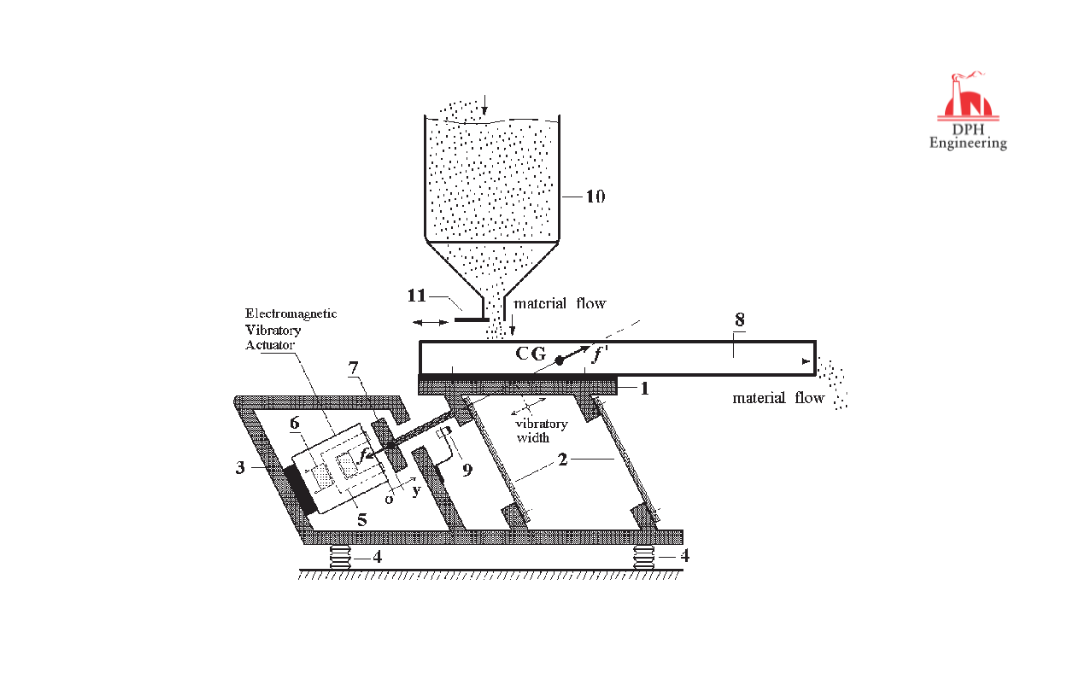Vibrating feeders are essential components in material handling, with three main types:
- Electromagnetic Vibratory Feeders
- Natural Frequency Vibratory Feeders
- Out-of-Balance Vibratory Feeders
This article focuses specifically on the workings of electromagnetic vibrating feeders, providing insights into their unique mechanisms and principles.
What is an Electromagnetic Vibrating Feeder?
Electromagnetic vibrating feeders are widely used machines in factories, serving various purposes such as moving, sorting, and packaging materials. These feeders come in many sizes, from small units that can fit on a lab desk to larger systems that transport materials over long distances. Regardless of their size, all electromagnetic vibrating feeders operate on the same basic principle.
How Vibrating Feeders Work
An electromagnetic vibrating feeder working principle involves shaking its tray to move materials. When an item is placed on the tray, the vibrations cause it to bounce in small jumps, creating a steady movement of the product. The angle of the springs underneath the tray determines the direction of movement. The product will move upwards from the box in the direction opposite to the angle of the springs.
System Arrangement
An electromagnetic vibrating feeder consists of several key parts: a base, a coil, flat springs, a magnet, and a tray. The flat springs connect the tray to the base, allowing them to move in relation to each other, facilitating product feeding.
The coil acts as an electromagnet, wrapped in copper wire and fixed to the base. The magnet is attached to the feeder tray. When the coil pulls the magnet toward it and then releases it, the base and tray move in opposite directions. These components work together in a drive system that combines the coil, magnet and springs into one unit. At the top of the springs, there’s a mounting plate that allows you to attach the appropriate feeder tray for the job.
Generating Product Movement
The electromagnetic feeder starts to shake when an electric current moves back and forth through the coil. Flat springs hold the magnet just a few millimeters away from the coil. When the current flows in one direction, the coil pulls the magnet closer, adding more force to the springs. When the current switches direction, the magnet is released, and the tension in the springs pushes the tray forward, causing items on the tray to jump forward. This repeated process creates a steady flow of products.
Components of a Vibratory Feeder
Springs
Connecting the springs to the vibratory feeder tray is more complicated than it seems. The electric drive uses a set frequency, adjustable with an inverter control system. Matching the frequency of the electromagnetic drive with the natural frequency of the tray’s movement on the springs helps reduce stress on the feeder tray, allowing the product to move smoothly and quickly.
The natural frequency depends on how stiff the springs are compared to the weight of the feeder tray and the items it holds. Since the specific use of the feeder affects the tray and product weight, the only variable we can adjust is the springs. Springs become stiffer with more of them, wider or thicker ones, while longer springs are less stiff.
Feeder Tray
The main job of the feeder tray is to direct the product to its destination. To do this effectively, the tray must securely hold the product and prevent spillage. A stiff tray transfers energy from the drive to the product efficiently. If the tray isn’t sturdy, different parts may move at different speeds, causing secondary movements, which can disrupt product flow.
Base
The base plays a crucial role beyond just holding the flat springs. Its weight stabilizes the feeder tray and prevents vibrations from affecting supporting structures. The base moves in the opposite direction of the tray at the same speed. Flexible rubber blocks connect the base to the support frame, ensuring stability while allowing slight movement.
During normal operation, the feeder tray moves up and down about 1.5 mm. To handle this without straining the rubber blocks, the base needs to be heavier. Generally, the base should be three times heavier than the tray and the product combined, maintaining a 3:1 mass ratio.
The relationship can be calculated as follows:
Base Mass×Base Amplitude=Tray Mass×Tray Amplitude\text{Base Mass} \times \text{Base Amplitude} = \text{Tray Mass} \times \text{Tray Amplitude}Base Mass×Base Amplitude=Tray Mass×Tray Amplitude
Let’s say:
- Base Mass = XXX
- Tray Mass = 111 (for simplicity)
- Base Amplitude = 0.5 mm0.5 \, \text{mm}0.5mm
- Tray Amplitude = 1.5 mm1.5 \, \text{mm}1.5mm
So,
X×0.5=1×1.5X \times 0.5 = 1 \times 1.5X×0.5=1×1.5 X=1×1.50.5=3X = \frac{1 \times 1.5}{0.5} = 3X=0.51×1.5=3
This means the mass ratio of the tray to the base should be 3:1. For feeding systems with higher amplitudes, ratios of up to 8:1 can be required.
Feeder Control Systems
Vibrating feeders are simple machines, so their control needs are minimal. Once a feeder is set up to perform its task, controls usually involve basic functions like “start” and “stop.” This type of control is common when the feeder regulates the flow of products into the next stage of production.
Vibrating Feeder Control Application
A common example of feeder control is when it discharges into a multihead weighing system. Since the multihead weigher can only handle a certain amount of product at a time, the feeder must stop when the input exceeds this limit. Sensors on the multihead weigher detect when the product level is too high. When this happens, a stop signal is sent to the feeder. Once the product is processed and the level decreases, the feeder will start again.
Variable Speed Control
Using an inverter allows for more control over the vibratory feeder system. It adjusts the speed of product movement by changing the feeder’s frequency. As the frequency increases, the product moves faster. However, this method isn’t always effective since the springs in the feeder are designed for specific frequencies, and raising the frequency too high can reduce efficiency.
In most production processes, variable speed control isn’t commonly used, as product flow typically relies more on the main processing equipment than on the feeder itself. However, it can be useful when measuring ingredients for a mixer. For example, a hopper can release most of an ingredient quickly while the last bit is added slowly to prevent overfilling.
This overview has covered the basic functioning of electromagnetic vibrating feeders, including their working principles and applications. If you have any questions or want to learn how a vibrating feeder could benefit you, feel free to reach out using the contact form at the bottom of the page.
Conclusion
In conclusion, electromagnetic vibrating feeders are essential in material handling, efficiently transporting various products in industrial settings. Understanding their operation—including the roles of key components and control systems—enhances their effectiveness. While basic controls involve starting and stopping the feeder, variable speed control can be beneficial for precise tasks. For more information or to see how these feeders can work for you, feel free to reach out.
FAQs
How does electromagnetic vibration work?
Electromagnetic vibrations are created by the uneven air-gap field produced by an eccentric rotor in electrical machines. This unevenness is linked to the rotor’s eccentricity, which often occurs in rotating electrical machines. As the rotor spins, the variations in the air-gap field generate vibrations. These vibrations can influence the performance and efficiency of the machine, and understanding this phenomenon is essential for optimizing machine operation and minimizing unwanted noise and wear.
What is the meaning of electromagnetic vibration?
Electromagnetic vibration refers to the energy created when electrons or other charged particles move or vibrate. This energy travels in the form of electromagnetic waves, which include light, radio waves, and other types of radiation.

